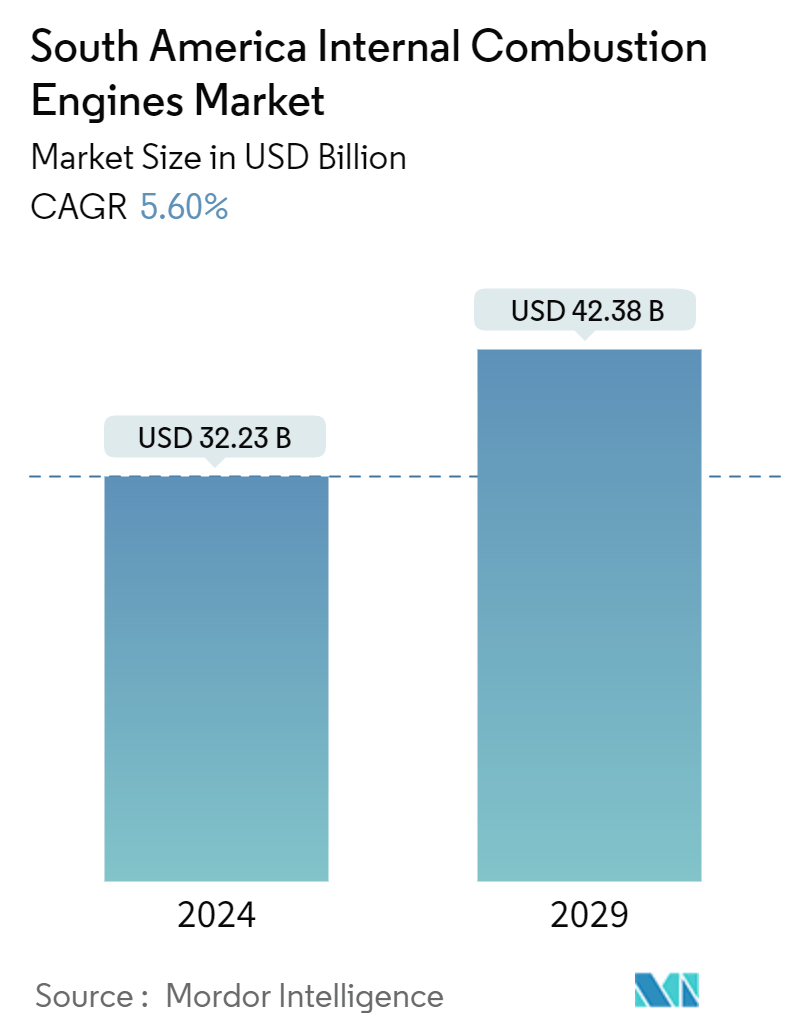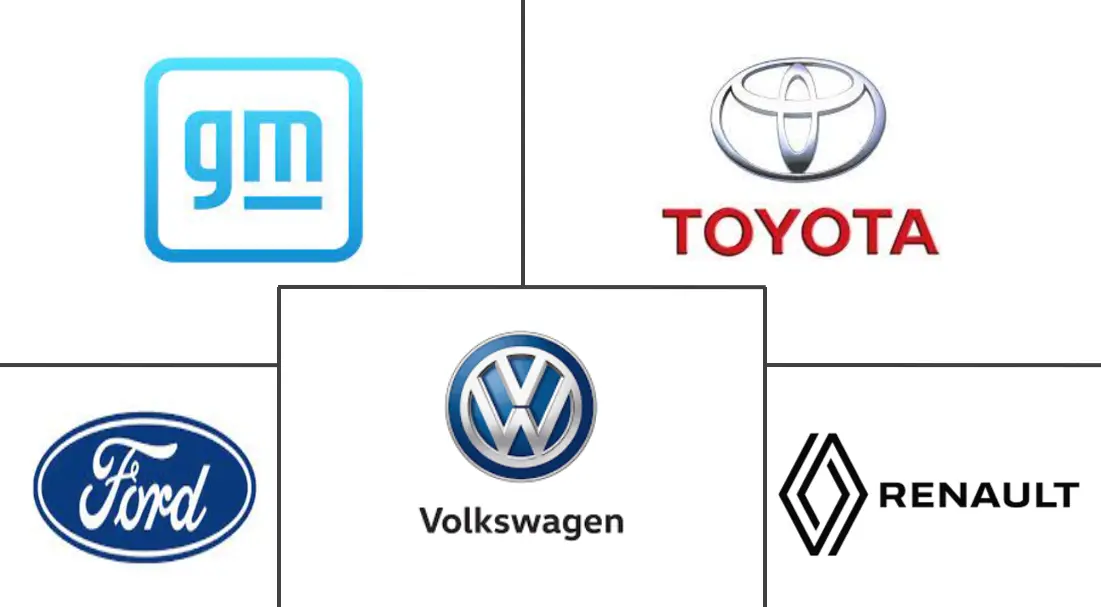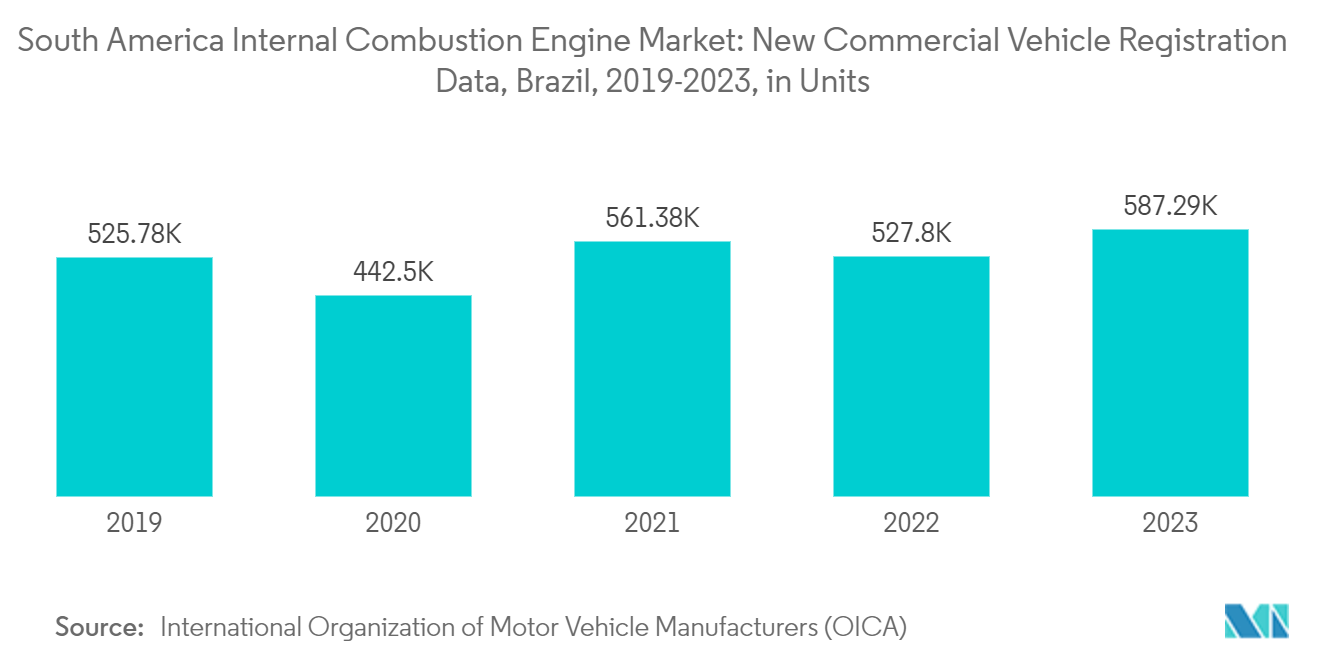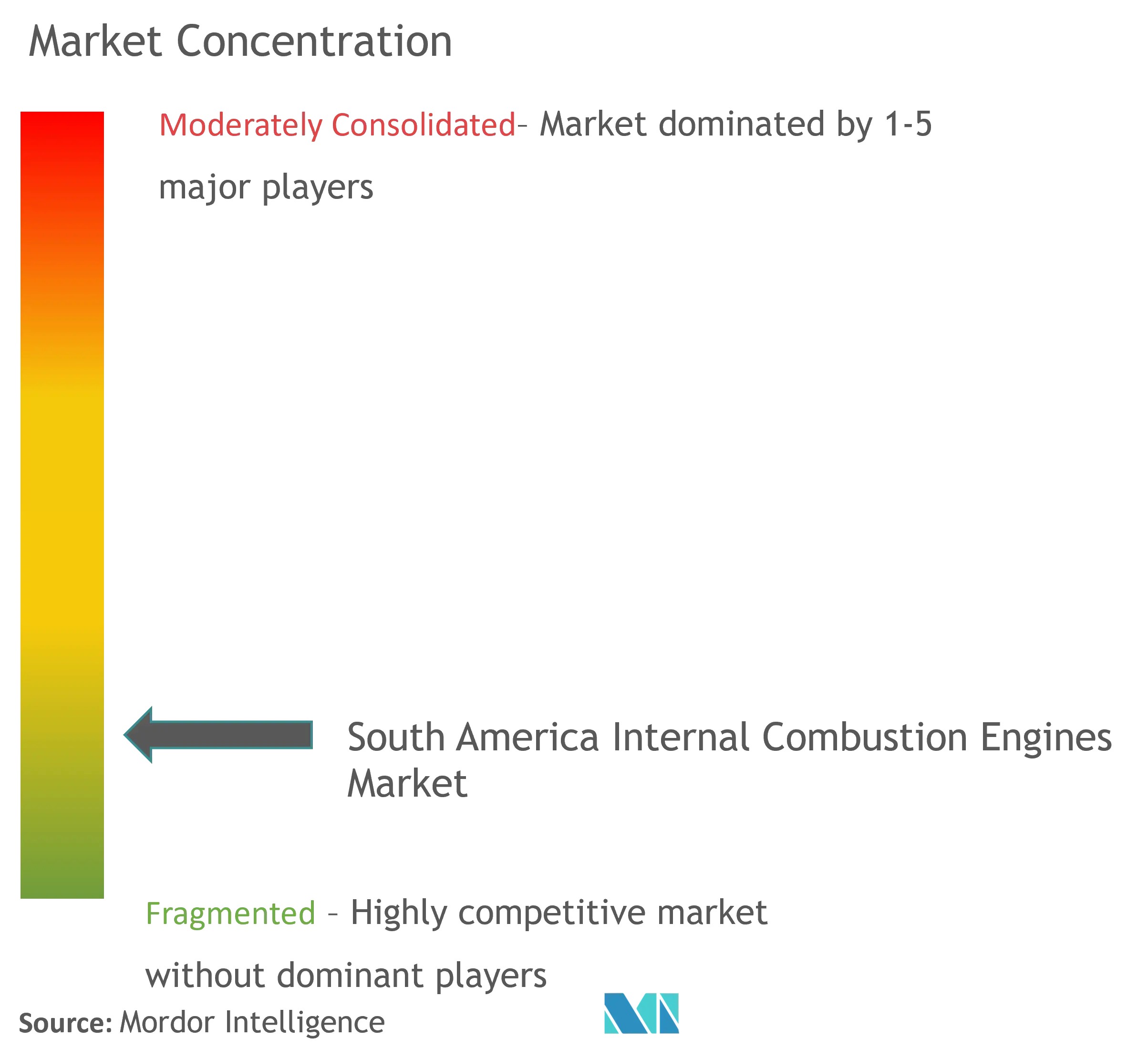South America Internal Combustion Engines Market Size

| Study Period | 2019 - 2029 |
| Base Year For Estimation | 2023 |
| Forecast Data Period | 2024 - 2029 |
| Market Size (2024) | USD 32.23 Billion |
| Market Size (2029) | USD 42.38 Billion |
| CAGR (2024 - 2029) | 5.60 % |
Major Players
*Disclaimer: Major Players sorted in no particular order |
South America Internal Combustion Engines Market Analysis
The South America Internal Combustion Engines Market size is estimated at USD 32.23 billion in 2024, and is expected to reach USD 42.38 billion by 2029, growing at a CAGR of 5.60% during the forecast period (2024-2029).
• Over the medium term, increasing demand for ICE two-wheelers and the rise of plug-in hybrid ICE vehicles (PHEV) are expected to drive the growth of the South America Internal Combustion Engines Market during the forecast period.
• On the other hand, the rising electric vehicle market and demand for the adoption of cleaner fuels in regard to the green climate goals are expected to hinder the growth of South America's Internal Combustion Engines Market during the forecast period.
• Nevertheless, technological innovation and adaptation of the latest technologies in plug-in hybrid vehicles are likely to create opportunities for the South America Internal Combustion Engines Market during the forecast period.
• Brazil dominates the market and is also likely to witness the highest growth during the forecast period.
South America Internal Combustion Engines Market Trends
Diesel is Likely to Dominate the Market
- Diesel Internal Combustion engines are one of the most significant internal combustion engines that have been in use since the 1870s. These engines are designed to generate mechanical energy after the combustion of an air-diesel mixture. No auxiliary component like a spark plug is used to ignite the air-diesel mixture; instead, it uses the elevating temperature of the air, which is compressed by a piston moving inside an engine block.
- The South American region has witnessed moderate growth in the demand for diesel engines in recent years, mainly driven by increasing investments in the construction sector, combined with increasing demand for uninterrupted power supplies and an increase in sales of diesel vehicles.
- Due to its advantages over gasoline engines, diesel engines have been used in several industries for decades. In recent years, the industry witnessed certain developments to cope with the global and country-based engine emission standards for automobiles like Euro 5 & 6, Bharat Stage 5 & 6, China V & VI (b), and a few others.
- Diesel ICE engines, being fuel fuel-efficient and having better acceleration, towing, and hauling potential than gasoline engines, have been quite a familiar and popular fuel source in South America. In addition to this, South America is also becoming a hub for developing ICE engines that can cope with biodiesel, a form of diesel, as a fuel, given the South American region is a major producer of biodiesel.
- In October 2023, MAHLE GmbH announced that it had established a Global Bio-Mobility Center in Jundiaí, Brazil, to support the development and global rollout of environmentally friendly combustion engines that can run on bio-diesel.
- Diesel engine vehicles have been a prominent feature of South America's transportation landscape for decades. Additionally, the biggest share of demand for diesel engines is coming from Brazil and Colombia. The moderate growth trend is also expected to continue during the forecast period.
- According to the International Organization of Motor Vehicle Manufacturers, a major share of the sales of new vehicle registration data from 2023 in South America was from diesel vehicles, which the graph showed is increasing when compared to the 2022 new vehicle registration data in South America, thus promising a strong market for Diesel ICE engines.
- Thus on the basis of the above points, diesel ICE engines will likely dominate the South America Internal Combustion Engines Market.

Brazil is Likely to Dominate the Market
- Brazil is a country that, in recent years, has yet to witness a fast transition from Fossil fuels to Electric vehicles in all commercial and private vehicles of all types, including Buses, Cars, Two-wheelers, and Trucks, because of the nation's geography, historic strong base for ICE engines, easy availability and well-supported infrastructure for diesel and gasoline fuels.
- Diesel engine vehicles have been a prominent feature of South America's transportation landscape for decades due to their power, efficiency, and affordability advantages.
- Internal Combustion Engine manufacturing in Brazil has been developing technologies such as selective catalytic reduction systems, particulate filters, and oxidation catalysts to reduce carbon emissions.
- On the other hand, Brazil has been showing a resonant use of both Fossil and Non-Fossil fuels, with the growing popularity among the nation's family households for the use of Plug-In Hybrid Electric vehicles in public transport and commercial heavy vehicles is key to the growth of Gasoline and Diesel powered ICE engines coupled with Battery packs.
- In September 2023, Renault, a French multinational automobile manufacturer in Brazil, announced that despite a Government Pushing for stricter vehicle emission control norms and standards, the company will continue its production of nine in 10 cars that are equipped to run on a mixture of gasoline and the biofuel, thus maintaining the production of ethanol-fueled internal combustion engine vehicles in Brazil.
- According to the International Organization of Motor Vehicle Manufacturers, a major share of new vehicle registration data sales from 2023 in Brazil was from diesel, gasoline, and PHEV vehicles, with the total of all three powertrains combined going close to 70%. The graph also showed an increasing sales trend for these ICE powertrain vehicles compared to the 2022 new vehicle registration data in Brazil, thus promising future positive outlooks for ICE Production market players in Brazil.
- Thus on the basis of the above points Brazil will dominate the South America Internal Combustion Engines Market during the forecast period.

South America Internal Combustion Engines Industry Overview
The South America Internal Combustion Engines Market is semi-fragmented. The key players in this market include (in no particular order) General Motors, Volkswagen Group, Volvo AB, MAN SE, Bayerische Motoren Werke AG, Ford Motor Company, Toyota Motor Corporation, and Renault Group.
South America Internal Combustion Engines Market Leaders
-
Toyota Motor Corporation
-
Volkswagen Group
-
Renault Group
-
General Motors
-
Ford motor company
-
MAN SE
*Disclaimer: Major Players sorted in no particular order

South America Internal Combustion Engines Market News
September 2023: Renault Group announced that it has plans to invest USD 400 million in the South American Country, Brazil, which includes a new vehicle platform to be produced in its Parana state industrial complex in Brazil that would allow the company to produce internal combustion engines in these facilities.
July 2023: BYD announced that it will build three factories 50 km from Salvador in the Camaçari complex, Brazil, with an initial investment of USD 620 million. The second manufacturing unit will produce PHEV, with an estimated 150,000 units/ year capacity in the first phase.
South America Internal Combustion Engines Market Report - Table of Contents
1. INTRODUCTION
- 1.1 Scope of the Study
- 1.2 Market Definition
- 1.3 Study Assumptions
2. EXECUTIVE SUMMARY
3. RESEARCH METHODOLOGY
4. MARKET OVERVIEW
- 4.1 Introduction
- 4.2 Market Size and Demand Forecast in USD billion, till 2029
- 4.3 Recent Trends and Developments
- 4.4 Government Policies and Regulations
-
4.5 Market Dynamics
- 4.5.1 Drivers
- 4.5.1.1 Increasing demand for ICE two-wheelers
- 4.5.1.2 Rise of plug-in hybrid ICE vehicles (PHEV)
- 4.5.2 Restraints
- 4.5.2.1 Rising Battery electric vehicle market
- 4.6 Supply Chain Analysis
-
4.7 Porter's Five Forces Analysis
- 4.7.1 Bargaining Power of Suppliers
- 4.7.2 Bargaining Power of Consumers
- 4.7.3 Threat of New Entrants
- 4.7.4 Threat of Substitutes Products and Services
- 4.7.5 Intensity of Competitive Rivalry
5. MARKET SEGMENTATION
-
5.1 By capacity
- 5.1.1 50 cm3 to 200 cm3
- 5.1.2 201 cm3 to 800 cm3
- 5.1.3 801 cm3 to 1500 cm3
- 5.1.4 1501 cm3 to 3000 cm3
-
5.2 By Fuel Type
- 5.2.1 Gasoline
- 5.2.2 Diesel
- 5.2.3 Others
-
5.3 Geography
- 5.3.1 Brazil
- 5.3.2 Chile
- 5.3.3 Argentina
- 5.3.4 Colombia
- 5.3.5 Rest of South America
6. COMPETITIVE LANDSCAPE
- 6.1 Mergers and Acquisitions, Joint Ventures, Collaborations, and Agreements
- 6.2 Strategies Adopted by Leading Players
-
6.3 Company Profiles
- 6.3.1 Market Players
- 6.3.1.1 Volkswagen Group
- 6.3.1.2 General Motors
- 6.3.1.3 MAN SE
- 6.3.1.4 Bayerische Motoren Werke AG
- 6.3.1.5 Hyundai Motors
- 6.3.1.6 Ford motor company
- 6.3.1.7 Renault Group
- 6.3.1.8 Toyota Motor Corporation
- *List Not Exhaustive
- 6.4 Market Ranking Analysis
- 6.5 List of Other Prominent Companies
7. MARKET OPPORTUNITIES AND FUTURE TRENDS
- 7.1 Technological innovation and adaptation of the latest technologies in plug-in hybrid vehicles
South America Internal Combustion Engines Industry Segmentation
An internal combustion engine, typically used in motive cars, trucks, buses, and locomotives, is a heat engine in which the combustion of a liquid/gaseous fuel occurs with air/oxygen in a combustion chamber that is an essential part of the working fuel. The chemical expansion of the high-pressure and high-temperature gases produced by combustion applies direct force to the engine's components. This force is typically applied to pistons, gas turbine blades, a rotor engine, or a jet engine.
The South American Internal Combustion Engines Market is segmented by capacity, fuel type, and geography. By capacity, the market is segmented into 50 cm3 to 200 cm3, 201 cm3 to 800 cm3, 801 cm3 to 1500 cm3 and 1501 cm3 to 3000 cm3. By Fuel Type, the market is segmented into Gasoline, Diesel, and Others. By Geography, the market is segmented into Brazil, Chile, Argentina, Colombia, and the Rest of South American Countries.
South America Internal Combustion Engines Market Research FAQs
How big is the South America Internal Combustion Engines Market?
The South America Internal Combustion Engines Market size is expected to reach USD 32.23 billion in 2024 and grow at a CAGR of 5.60% to reach USD 42.38 billion by 2029.
What is the current South America Internal Combustion Engines Market size?
In 2024, the South America Internal Combustion Engines Market size is expected to reach USD 32.23 billion.
Who are the key players in South America Internal Combustion Engines Market?
Toyota Motor Corporation, Volkswagen Group, Renault Group, General Motors, Ford motor company and MAN SE are the major companies operating in the South America Internal Combustion Engines Market.
What years does this South America Internal Combustion Engines Market cover, and what was the market size in 2023?
In 2023, the South America Internal Combustion Engines Market size was estimated at USD 30.43 billion. The report covers the South America Internal Combustion Engines Market historical market size for years: 2019, 2020, 2021, 2022 and 2023. The report also forecasts the South America Internal Combustion Engines Market size for years: 2024, 2025, 2026, 2027, 2028 and 2029.
South America Internal Combustion Engines Industry Report
Statistics for the 2024 South America Internal Combustion Engines market share, size and revenue growth rate, created by Mordor Intelligence™ Industry Reports. South America Internal Combustion Engines analysis includes a market forecast outlook for 2024 to 2029 and historical overview. Get a sample of this industry analysis as a free report PDF download.



